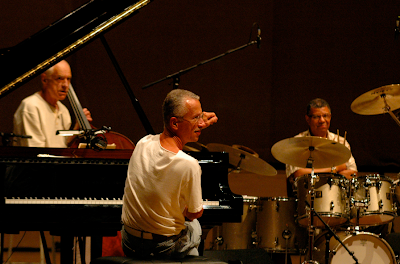This is how Bill Evans was appraised when free jazz exploded. Later, the critics realized that circumspectly and without being the leader of any particular current, he had led as profound a revolution as John Coltrane or Ornette Coleman. Without ever systematizing the contributions of modal jazz (which he helped found), he drew deep inspiration from it. His work as a composer surely borrowed from his charms of the old standards, of which he was very fond; but he lightened their often limited harmonic frames and broadened the field of melodic possibilities.
 |
| Bill Evans |
More significantly, due to the quality of his touch, he inaugurated a new approach to the jazz piano, which, until that point, had primarily been used as a percussion instrument. Bill Evans was not a barroom piano player; he was a concert pianist. His trio (piano, double bass, drums), which he used as a chamber orchestra, broke new ground.
 |
| Scott LaFaro, Bill Evans, Paul Motian |
From 1960 to 1961, Scott LaFaro (bass) and Paul Motian (drums) freed themselves from their role as mere accompanists and became soloist on an equal footing with the piano; the three participated in a triangular conversation. Collective and interactive, improvisation became more than ever a question of mutual listening and finding one's own place while treating the others' with respect. The revolution led by John Coltrane with sound and fury was conducted by Bill Evans' trios with a delicacy that evoked the intimacy of Claude Debussy.
 |
| (L-R) Steve Swallow, Walter Perkins, Art Farmer, Jim Hall |
Thus, along with such contemporaries as Jim Hall, who shared his concerns, Bill Evans left his mark on generations of musicians: on pianist, of course (Keith Jarret, Paul Bley and Chick Corea), but also on drummers (Jack DeJohnette), bass players (Gary Peacock), and saxophone players, trumpet players and bandleaders.
 |
| Gary Peacock, Keith Jarret, Jack DeJohnette (2012) |
____________________
No comments:
Post a Comment